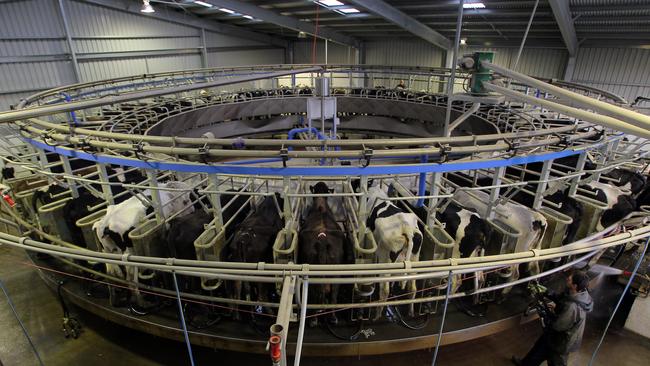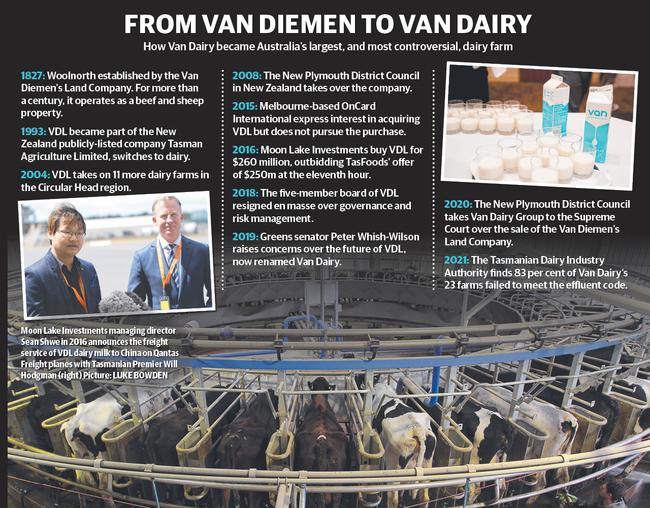Chinese investors set to sell remaining portion of former VDL dairy
Australia’s largest dairy farm is held in foreign hands, and as our in-depth analysis reveals, its future now part of it is for sale is a vexed issue.

Located on the far north-western tip of Tasmania, Van Dairy is Australia’s largest dairy farm. It is also one of the nation’s most controversial.
Employing more than 100 locals in the Smithton region, the future of the site that hosts the historic Woolnorth property is of significant economic importance not only to the district but the island state more broadly.
In 2016, the Foreign Investment Review Board approved the application of Chinese-owned Moon Lake Investments to buy the Van Diemen’s Land Company.
Moon Lake Investments subsequently changed its name to Van Dairy Limited.
At the time of the 2016 sale, VDL was Australia’s largest dairy operation, with 18,000 cattle spread over 7000 hectares — a land mass larger than Bermuda.
But that huge holding has been sliced this calendar year.

In June, Melbourne investment company Prime Value purchased 11 of the 25 dairy farms from Van Dairy an estimated $62 million, leaving 14 remaining.
The sale surprised locals at the time and there’s been speculation since about whether Van Dairy will exit Australia altogether.
The remaining parcel covers 5000 hectares, including the historic Woolnorth property.
While industry insiders have told The Weekly Times that Van Dairy is poised to sell entirely, owner Xianfeng Lu said he remained committed to the region.
However, he noted his company had: “earmarked two farms for sale, including the 900-hectare Harcus Dairy, due to operational requirements.”
Mr Lu said he had never considered selling all the farms and had also refused offers to buy the entire estate.
“I will not sell the entire VDL farms,” Mr Lu said.
“We want to make VDL a well-known international brand in the Tasmanian organic dairy industry.”
A spokeswoman for Prime Value declined to comment when contacted by The Weekly Times.
But Prime Value’s move into a sizeable slab of Van Dairy earlier this year was unanticipated by most in the sector and future changes on Tasmania's north-west pastoral peninsula cannot be ruled out.
Circular Head mayor Daryl Quilliam leads the council area that covers the Van Dairy site.
Cr Quilliam said locals would prefer to see Woolnorth and the remaining Van Dairy holding under Australian ownership but noted it had always been in foreign hands.
“Woolnorth and the (remaining part of Van Dairy) is a significant employer in the Circular Head council area — about 100 people are employed over 11 or 12 farms as well as in an office in Smithton,” the mayor said.
Earlier this year, legendary businessman Dick Smith called for the remaining part of Van Dairy to be purchased by Australian interests.
“We should try to buy it,” Mr Smith told Hobart’s Mercury newspaper, noting much-loved brands Vegemite and Rosella had returned to the Australian fold in the past decade.
However, such a move would be a first for the mega farm.
It was founded and managed out of London when founded in the 1830s and the British controlled what was then a sheep and beef property right up until 1993.
The Van Diemen’s Land Company then switched to New Zealand ownership under the New Plymouth District Council, which then sold the property to Mr Lu five years ago.
“Of course, it’d be great to see it in Australian hands. But we’d welcome any investor who wants to maintain employment at current levels and that’s most likely to be achieved through dairy,” Cr Quilliam said.
“Prior to the early 1990s, it was a beef and sheep farm and the change to dairy boosted job numbers.”
Van Dairy has received significant media scrutiny in recent years with claims of suboptimal standards.
Officers from the Tasmanian Dairy Industry Authority visited all Van Dairy Group farms between February 22 and 26 this year to assess whether there had been compliance with the Farm Dairy Effluent Management Code of Practice.
In a report sent to Mr Lu, TDIA manager Carolyn Harris said 83 per cent of the farms audited failed to meet the requirements of the code.
The office of Tasmanian Agriculture Minister Guy Barnett declined to comment when contacted by The Weekly Times.
However, the Minister said in June that: “The issues at Van Dairy farms do not reflect the Tasmanian dairy industry as a whole.
“The TDIA has considerable powers to deal with these identified issues and the Government receives regular briefings from the TDIA, as the independent regulator and also from my Department.”
Van Dairy has been the subject of considerable debate in the Tasmanian Parliament with state Greens leader Cassy O’Connor critical of government oversight.
“The Tasmanian and Australian governments have failed in their oversight of Van Dairy’s operations. Many Tasmanians have been both sickened and saddened by what’s happened to VDL,” Ms O’Connor said.
“The Greens would welcome a fresh start for this extraordinary property, and encourage government to facilitate responsible new ownership – preferably with some Tasmanian investment.”
So who is Xianfeng Lu?
Little is known about the Chinese-born businessman’s background, although he was initially known in his homeland for work in the textile sector.
In the past week, he has been keen to emphasise that he is now an Australian permanent resident.
What is known is that he was savvy enough to outbid some of Australia’s best-known business brains — Kathmandu clothing empire founder Jan Cameron and Rob Woolley’s TasFoods company — in his quest for the Tasmanian mega farm five years ago.
Ms Cameron took her fight for the property to Canberra, seeking the intervention of the Foreign Investment Review Board and meeting with top officials.
“The Chinese are under so much pressure to feed their 1.2 billion people, they’re acquiring the land they need to control the agricultural production,” Ms Cameron said after meeting with then Agriculture Minister Barnaby Joyce in 2016.
“They’re doing this for their food security at the cost of our food security. Once the Chinese buy this land, it will never be resold.’’
And despite sell-offs and piles of public scrutiny, Mr Lu may well prove Ms Cameron correct.
The Van Dairy owner said if and when the two farms were sold, his company would continue to own around 16,000 hectares of the Woolnorth property.
“My goal is to build an international high quality dairy company and I remain committed to this outcome,” Mr Lu said.
MORE



